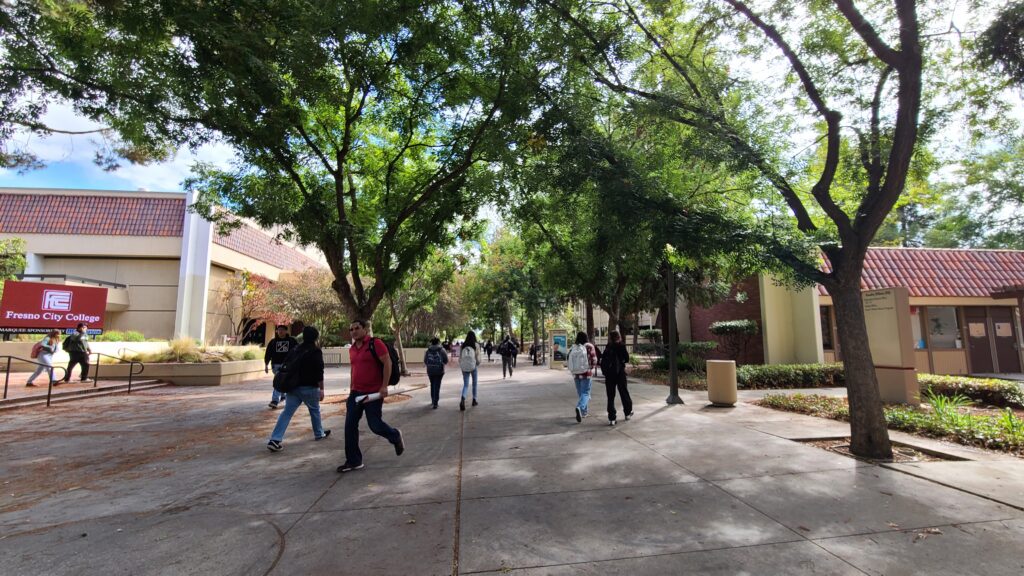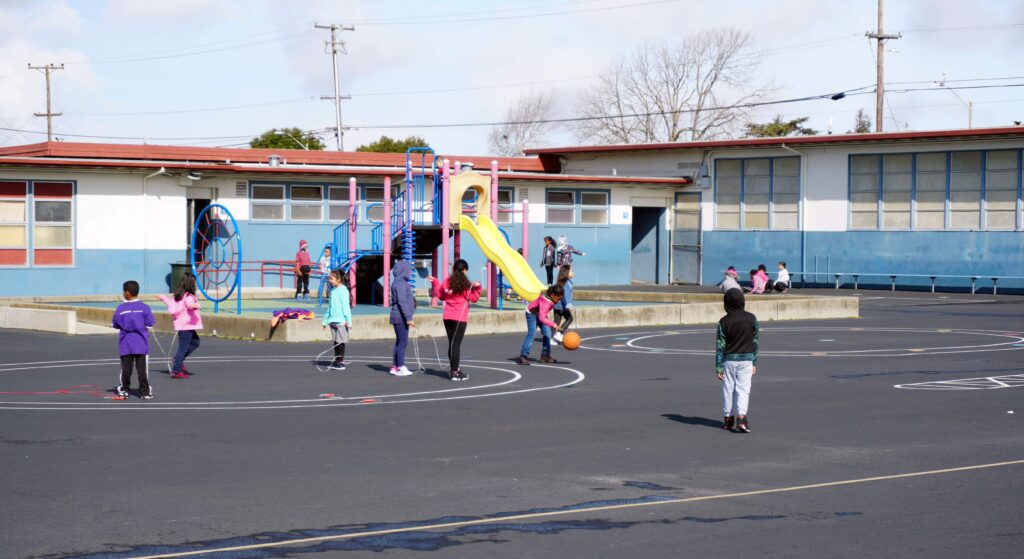
Community college students like those at Fresno City College would benefit the most from Cal Grant expansion.
Credit: Ashleigh Panoo/EdSource
A long-awaited expansion to financial aid in California, once expected to go into effect this year, is now facing uncertainty.
As part of California’s 2022 budget deal, lawmakers agreed to reform the Cal Grant, the state’s main financial aid program, to make it easier to understand, and expand eligibility by about 150,000 additional students, most of them low-income community college students.
But the 2022 agreement was contingent on sufficient state revenues to implement the reform, which would cost an estimated $365 million annually. And with California now facing at least a $38 billion deficit, Gov. Gavin Newsom has not committed to funding the reform, casting serious doubt on whether it will be included in this year’s budget.
That’s concerning to college access advocates and students who say the current Cal Grant program is too complicated and leaves out some of the state’s lowest-income students while the cost of attending college continues to rise.
Key lawmakers and other supporters say they plan to push for expanding the Cal Grant this year, even if they can’t get everything they initially hoped.
The Cal Grant, California’s key financial aid program, gives undergraduates grants of as much as $13,752 annually for tuition and fees, depending on the college. Students can also receive grants for living expenses. But the program is layered and confusing, awarding students different amounts depending on where they attend. Eligibility requirements also vary.
In his 2024-25 budget proposal, Newsom maintains the state’s funding for college financial aid, including $2.5 billion for Cal Grant and $636.2 million for Middle Class Scholarship, but skips a one-time funding increase for the scholarship that was part of last year’s budget agreement.
Assemblymember David Alvarez, chair of the Assembly’s budget subcommittee on education finance, said he has directed his staff to look at each element of Cal Grant reform and identify what can be done under this year’s budget constraints. He plans to hold hearings on the issue this spring.
“It was a significant commitment to increase access to more students,” Alvarez said in an interview. “And to the extent that we can create access to more students, if it has to be done in smaller steps, I’m willing to entertain that.”
The proposed reform calls for multiple changes. It would simplify the structure of the program by narrowing it to only two awards: one Cal Grant for community college students and another for students at four-year colleges. The current program has eight different Cal Grant awards, creating what critics say is an unnecessarily complicated system for awarding aid.
Earning a Cal Grant would also be easier. While some Cal Grants are currently lottery-based, all aid would be guaranteed under the new system to eligible students. And more students would be eligible thanks to the elimination of certain requirements.
For community college students, there would no longer be a grade point average requirement. University of California and Cal State students would need a 2.0 GPA — down from the 3.0 GPA currently required. There would also be no requirements specifying age cutoffs or how long a student has been out of high school that currently exist for UC and Cal State students, rules that prevent many older students from getting aid.
Income eligibility would be based on federal Pell Grant rules. For both awards, students would be eligible if their family’s household income is low enough to qualify for a Pell Grant. The median household income of a Pell Grant-eligible student is about $59,000. Officials say using the Pell Grant as a bar for eligibility will help increase the number of students eligible.
Eligible community college students would get an annual award of at least $1,648 to go toward nontuition expenses like housing and food. Most of those students already pay nothing in tuition. The awards for UC and Cal State students would cover the full cost of tuition, which in 2024-25 will be $14,436 for entering in-state UC students and $6,084 for entering in-state Cal State students. The awards won’t cover nontuition expenses, but students would still be free to seek federal, private and UC-administered aid to cover those costs.
In total, the changes would expand Cal Grant eligibility from just over 340,000 students to about 492,000 students, the California Student Aid Commission estimates.
Expanding aid to that many students would be costly, especially in the short term, but it could have long-term financial benefits for the state, argued Jake Brymner, deputy director of policy for the California Student Aid Commission. Not being able to afford college is the main reason many students either choose not to enroll at all or don’t finish college.
“This is so critical to our talent pipeline, to California’s workforce and to our ability to maintain robust state revenue on a wide tax base with folks who are moving into meaningful careers,” he said.
Newsom’s staff has yet to rule out the possibility that Cal Grant reform could be implemented this year. “We don’t speculate,” a spokesperson for Newsom’s Department of Finance said. “The law always envisioned us making a determination in May and we have not made any determination yet.”
The state’s revenues, however, speak for themselves. Newsom said during his January budget proposal that the state faces a $38 billion deficit. That was $30 billion lower than what the state’s Legislative Analyst Office had estimated. Lisa Qing, a policy analyst with that office, said in an email that Cal Grant expansion “would not be triggered under existing law” based on current revenue projections.
Qing added, though, that lawmakers could change existing law, such as by creating a different set of conditions to trigger Cal Grant expansion at a future date.
“There should be some sort of negotiation,” said David Ramirez, the UC Student Association’s governmental relations chair and part of the Cal Grant Reform Coalition. The coalition includes higher education advocacy organizations, civil rights groups and students who want to see the reform implemented.
“It was really troublesome to not see it funded at all” in Newsom’s January budget proposal, added Ramirez, a senior at UCLA studying geography, environmental studies and labor studies.
One potential solution, Ramirez said, could be to cut funding for the state’s Middle Class Scholarship and use those dollars to fund Cal Grant reform.
Convincing lawmakers to cut funding from the Middle Class Scholarship could be difficult, Ramirez acknowledged. But he said it would keep with his goal of prioritizing the state’s lowest-income students.
“It’s a very political thing, making sure that there’s funding for the Middle Class Scholarship, because people want to please their constituents,” he added.
Another potential compromise would be to implement some but not all elements of the reform, but Ramirez said the coalition is still trying to “assess and identify” which parts of Cal Grant reform should be prioritized over others.
Knowing what might be possible should become clearer this spring when Alvarez’s committee holds its hearings on the topic.
“The commitment is focused on increasing access to higher education for more students,” Alvarez said. “That’s what Cal Grant reform was about. And I don’t think anybody changed their mind about the importance of increasing access and reducing the cost of higher education for students.”





